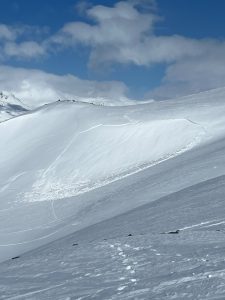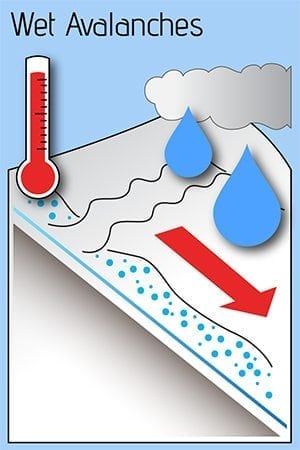Valdez
Above 4,000ftConsiderable
2,000 to 4,000ftModerate
Below 2,000ftModerate
Degrees of Avalanche Danger
Avalanche Problems
Problem 1
Snowfall has been slowly accumulating since 4/4 with 8-12+ inches likely at upper elevations. An uptick in West – southwest winds yesterday afternoon will have redistributed new snow into a more cohesive slab in areas exposed to wind such as high elevation ridge lines and wind channeled terrain. The sensitivity of new snow will be higher in areas where wind has created stiffer slabs. Human triggered avalanches will also be possible in areas unaffected by wind in specific locations such as convex terrain.
Pay attention to new snow depth, wind distribution patterns, and test the sensitivity of new snow using small inconsequential test slopes and hand shear tests. The new snow will need time to bond with the underlying snowpack. Careful snowpack assesment and cautious route finding will be important for safe travel in avalanche terrain today.
Likelihood:
- Almost Certain
- Very Likely
- Likely
- Possible
- Unlikely
Size:
- Historic
- Very Large
- Large
- Small
Trend
- Increasing
- Steady
- Decreasing
Problem 2
Wet loose activity is likely today. New snow will easily be affected by the strong April sun. Expect for steep solar aspects to have natural wet loose activity. East aspects will be the first to be affected moving to south and then finally west. Clouds are forecasted to roll in later in the day which could limit the amount of activity that we see today.
The spring shed has been minimal so far this year at mid and upper elevations. Activity is forecasted to increase in the coming days as warmer temps move into upper elevations and new snow continues to slowly accumulate.
Timing is key in avoidance of this avalanche problem. Pay attention to the amount of warmth that is being transferred into the snow surface (Is it becoming moist-wet?). In general, it is recommended to avoid traveling on or being exposed to steep solar aspects, especially during the heat of the day.
Likelihood:
- Almost Certain
- Very Likely
- Likely
- Possible
- Unlikely
Size:
- Historic
- Very Large
- Large
- Small
Trend
- Increasing
- Steady
- Decreasing
Problem 3
Persistent weak layers in our snowpack have been dormant in our forecast area for ~10 days. The new snow we are currently receiving is unlikely to tip this balance. There is the potential for weak layers in our mid snowpack to reactivate later in the spring as solar radiation becomes more intense or if we enter a period where heavy precipitation returns. At the present instabilities are concentrated near the surface and triggering a persistent slab avalanche is unlikely.
Likelihood:
- Almost Certain
- Very Likely
- Likely
- Possible
- Unlikely
Size:
- Historic
- Very Large
- Large
- Small
Trend
- Increasing
- Steady
- Decreasing
Problem 4
Weak snow exists at the base of our snowpack. This weak snow is currently unlikely to be affected due to the strength of old wind affected snow at the 3/17 new/old interface. Depth hoar may become a concern later in the season if our area returns to a period of major snowfall and the very strong wind damaged layer at the new/old interface starts to break down and lose strength within the snowpack. As very hard wind slabs break down within the snowpack a person or machines weight will have a more direct affect on weak layers at the bottom of the snowpack. In addition, the increasing intensity of the sun will be putting pressure on deep layers during the heat of the day.
Likelihood:
- Almost Certain
- Very Likely
- Likely
- Possible
- Unlikely
Size:
- Historic
- Very Large
- Large
- Small
Trend
- Increasing
- Steady
- Decreasing
Avalanche Activity
Below is a summary of observed Avalanche activity from the last 7 days. Avalanches that were noted earlier in the season can be viewed by clicking the link below.
If you trigger or observe an avalanche consider leaving a public observation.
4/6- Skier triggered D1 reported in Gully 1 on a wind loaded convexity.
4/2- D1.5 skier triggered wind slab avalanche. NW aspect/~4000′.

4/1- Multiple skier triggered D1 avalanches were reported on a variety of aspects. These were wind slabs in the 4-8 inch range.
3/31- Skier triggered avalanche reported at high elevation of the Maritime climate zone. This failed on surface hoar that was buried on 3/30. No skier involvement. Crown depth was 4-8 inches.
3/24- Ski cuts were reported as being productive, with avalanches up to D2 at the 3/21 interface.
3/18-21- Several D1-D2 human triggered avalanches have been reported. For the most part these have been outside our forecast zone and appear to be more likely in areas with either a weaker underlying snowpack (continental zone) or where storm totals were higher (SE of Thompson Pass). Remote triggers have also been reported as the Hamilton storm slab has settled and gained cohesion.
3/17- Multiple D1-D2 natural storm slab avalanches were reported and observed along the road corridor. These all failed within the storm snow with the exception of one deep persistent avalanche reported on Billy Mitchell.
Weather
Check out our updated weather tab! A collection of local weather stations are available for viewing with graphs and tabular data included.
NWS Watches, warnings and advisories
NONE
NWS Point forecast for Thompson Pass
Date Friday 04/07/23 Saturday 04/08/23 Time (LT) 04 10 16 22 04 10 16 22 04 Cloud Cover OV OV OV OV OV OV OV OV OV Cloud Cover (%) 70 70 85 90 95 85 75 90 95 Temperature 16 20 27 23 19 23 30 24 21 Max/Min Temp 28 19 30 17 Wind Dir E E S SE E NE NE NE NE Wind (mph) 4 5 6 5 3 5 6 9 12 Wind Gust (mph) Precip Prob (%) 20 40 50 50 40 30 20 60 60 Precip Type S S S S S S S S S 12 Hour QPF 0.04 0.04 0.04 0.09 12 Hour Snow 0.0 0.0 0.0 1.0 Snow Level (kft) 0.0 0.0 0.0 0.0 0.0 0.0 0.1 0.1 0.0
Click on link below for Thompson Pass weather history graph:

| Date:
04/07 |
24 hr snow | HN24W* | High temp | Low temp | 72 hour SWE* | April snowfall | Seasonal snowfall | Snowpack Depth |
| Valdez | 0 | 0 | 42 | 26 | .15 | 2 | 239 | 48 |
| Thompson Pass | N/O | N/O | N/O | N/O | N/O | N/O | 428 | N/O |
| 46 mile | N/O | N/O | 37 | 9 | 0 | 0 | ~115** | 54 |
*HN24W- 24 hour Snow water equivalent in inches
*SWE– Snow water equivalent
**46 mile seasonal snowfall total begins December 1st.
Additional Information
Click on the link below for a running summary of the seasons weather history.
Announcements
The avalanche hazard is Considerable above 4000 feet and moderate below. Human triggered avalanches 1-2 feet in depth are likely in areas where recent west – south west winds have redistributed recent new snow. Natural avalanches are possible. Cautious route finding and conservative terrain choices will be essential for safe travel in avalanche terrain today.
Posted by Gareth Brown 04/7 8:00 am.
For a description of current avalanche problems, weather information, season history and more click the (+ full forecast) button. Avalanche forecasts will be issued Wednesday-Sunday.
If you have pictures of recent natural or human triggered avalanches or notice signs of instability such as shooting cracks or collapsing, leave an observation to help improve forecast accuracy.



